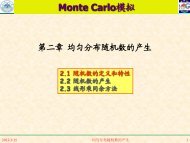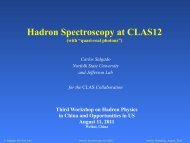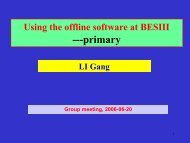大 亚 湾 实 验 结 果 唯 象 学 后 果
大äºæ¹¾å®éªç»æçå¯è±¡å¦åæ - HEPG
大äºæ¹¾å®éªç»æçå¯è±¡å¦åæ - HEPG
- No tags were found...
Create successful ePaper yourself
Turn your PDF publications into a flip-book with our unique Google optimized e-Paper software.
<strong>大</strong> <strong>亚</strong> <strong>湾</strong> <strong>实</strong> <strong>验</strong> <strong>结</strong> <strong>果</strong> 的 <strong>唯</strong> <strong>象</strong> <strong>学</strong> <strong>后</strong> <strong>果</strong><br />
1<br />
A: The Daya Bay result<br />
( 春 天 的 故 事 )<br />
邢 志 忠<br />
B: The phenomenology<br />
( 敢 问 路 在 何 方 )<br />
C: Concluding remarks<br />
( 传 奇 )<br />
Disclaimer: 报 告 人 的 观 点 只 代 表 其 个 人 的 科 <strong>学</strong> 见 解<br />
@ 山 东 <strong>大</strong> <strong>学</strong> 物 理 <strong>学</strong> 院 , 二 零 一 二 年 三 月 十 六 日 下 午
Three Swordsmen<br />
2<br />
Groundbreaking: October 2007
Part A<br />
March 8<br />
3<br />
News Release +<br />
Special Seminar<br />
2<br />
sin 2 13<br />
0.092 0.016(stat)<br />
0.<br />
005 (syst)<br />
8.8 0.8<br />
<br />
13
Part A<br />
The Experiment<br />
4<br />
Near detector<br />
55 days of data<br />
Far detector<br />
10416 events<br />
Disappearance neutrino oscillations:<br />
Near detector
The rate-only analysis<br />
Input (MINOS 2011):<br />
m<br />
2.32 10 eV<br />
2 0.12 3 2<br />
31 0.08<br />
Result (best-fit ±1):<br />
8.8 0.8<br />
<br />
13<br />
arXiv:1203.1669 (submitted to PRL)
The dip<br />
The preliminary shape analysis
Part A<br />
A Milestone<br />
7<br />
France Korea China<br />
The preliminary hints in 2011<br />
T2K (Japan): 2.5<br />
MINOS (USA): 1.7<br />
~8 <br />
13<br />
Double Chooz (France): 1.7<br />
Signature in HEP<br />
< 3 (hint)<br />
3~5 (evidence)<br />
> 5 (discovery)<br />
5.2
Fritzsch-Xing Plot (28 fundamental parameters in Nature)<br />
m d<br />
M W<br />
m u<br />
m s<br />
12<br />
<br />
12<br />
m c<br />
m b<br />
13<br />
<br />
G N<br />
s<br />
13<br />
m t<br />
m e<br />
23<br />
w<br />
23<br />
m 1<br />
m <br />
q<br />
<br />
l<br />
m 2<br />
m <br />
M H<br />
m 3<br />
Z.Z. Xing
R. Davis 1968<br />
A. McDonald<br />
SNO 2001<br />
M. Koshiba<br />
1987<br />
9<br />
Reactor<br />
anti-’s<br />
F. Reines,<br />
C. Cowan<br />
1956<br />
A. Suzuki<br />
KamLAND<br />
2002<br />
Daya Bay<br />
2012<br />
KamLAND 2005<br />
Borexino 2010<br />
Y. Totsuka, T. Kajita SK 1998
Part A<br />
Quarks (63 — 73):<br />
Flavor Mixing<br />
10<br />
Experiments:<br />
Leptons (1962):<br />
θ 12<br />
θ 23<br />
θ 13<br />
δ → new physics ?<br />
~13° ~2° ~0.2° ~65° unitarity ?<br />
turning point<br />
(we assume three Majorana neutrinos + unitarity)<br />
P<br />
θ 23<br />
θ 12<br />
θ 13<br />
δ/ρ/σ new physics ?<br />
~45° ~34° ~9° ~? ? ? unitarity ?
Part B<br />
Origin of Flavor Mixing<br />
11<br />
Weak interaction (flavor) state:<br />
Mass state:<br />
Weak charged-current interactions:<br />
The MNSP matrix:<br />
mass matrices
Part B<br />
Two Strategies<br />
12<br />
Strategy (A): flavor mixing angles depend on mass ratios.<br />
Strategy (B): constant leading term<br />
+ perturbation matrix.<br />
1996<br />
Some linear<br />
correlations<br />
or equalities<br />
1977<br />
22 33<br />
Texture zeros<br />
1978<br />
S. Weinberg H. Fritzsch<br />
Flavor symmetries
Part B<br />
Flavor Symmetries<br />
Guiding Principle<br />
13<br />
The Flavor or Family Symmetry might be the promising way towards<br />
deeper understanding of fermion mass generation and flavor mixing<br />
(Harari et al 78; Froggatt, Nielsen 79; ……).<br />
Flavor Symmetry<br />
S 3<br />
, S 4<br />
, A 4<br />
, Z 2<br />
, U(1) F<br />
, SU(2) F<br />
, ……<br />
Symmetry Breaking<br />
李 政 道 -Friedberg<br />
Observed patterns of fermion masses and flavor mixing
Part B<br />
Texture Zeros<br />
14<br />
Example: 15 two-zero textures of the Majorana neutrino mass matrix.<br />
Frampton, Glashow, Marfatia:<br />
hep-ph/0201008<br />
(02 Jan 2002)<br />
Phys. Lett. B 536<br />
(2002) 79<br />
30 May 2002 180 citations<br />
doing research is a fun<br />
Xing:<br />
hep-ph/0201151<br />
(17 Jan 2002)<br />
Phys. Lett. B 530<br />
(2002) 159<br />
28 March 2002<br />
100 citations
Part B<br />
Constant Patterns<br />
15<br />
Example (A): Democratic FlavorMixing Pattern (Fritzsch, Xing 1996).<br />
Example (B): Tri-bimaximal Flavor Mixing Pattern (Harrison, Perkins,<br />
Scott 2002; Xing 2002; He, Zee, 2003)
Part B<br />
Perturbations<br />
16<br />
To illustrate, we typically take<br />
Democratic<br />
The nine matrix elements are all O(0.1) ---- natural?<br />
Tri-bimaximal<br />
The smallest (largest) angle receives the maximum<br />
(minimum) correction ---- unnatural?
Part B<br />
Quantum Corrections<br />
17<br />
A mechanism of neutrino mass generation most<br />
likely works at a super-high energy scale. After<br />
integrating out heavy degrees of freedom, one<br />
is left with the unique Weinberg operator:<br />
0 9 <br />
New Physics Scale<br />
Impossible<br />
unless ……<br />
arXiv:1203.3118<br />
RGEs = Cable Car<br />
罗 舒<br />
To compare a theory with experiments,<br />
one must run the RGEs of the effective<br />
-mass matrix down to low energies:<br />
RGE = renormalization-group equation<br />
Electroweak Scale
Part B<br />
Initially 0 ?<br />
13<br />
<br />
18<br />
Example (A): Tetra-maximal mixing (Xing, 2008)<br />
Example (B): Correlative mixing (Xing, Jan 2011)<br />
Comment (1): it is easier to get perturbations or quantum corrections<br />
Comment (2): it is not easy to get such a pattern from group theories
Part B<br />
How to Play?<br />
19<br />
What distinguishes different families of fermions?<br />
----- they have the same gauge quantum numbers,<br />
yet they are quite different from one another.<br />
★ Radiative Mechanism (S. Weinberg 1972; A. Zee 1980)<br />
★ Texture Zeros (S. Weinberg; H. Fritzsch 1977; H. Fritzsch 1978)<br />
★ Family Symmetries (H. Harari et al 1978; C. Froggatt, H. Nielsen 1979)<br />
★ Seesaw Mechanism (P. Minkowski 1977; T. Yanagida 1979; ……)<br />
★ Extra Dimensions (K. Dienes et al; G. Dvali, A. Smirnov 1999)<br />
Our Philosophy
Part B<br />
The Structure<br />
20<br />
Off-diagonal asymmetries<br />
of the CKM matrix:<br />
Almost symmetric!<br />
The MNSP matrix exhibits an approximate symmetry in modulus:<br />
9<br />
<br />
13<br />
Conditions:<br />
or<br />
What to do<br />
next ?
Part B<br />
The 1 st Paper on CPV<br />
21<br />
Quarks:<br />
The Cabibbo Texture: the tri-maximal mixing + maximal CP violation:<br />
The Jarlskog invariant:
Part B<br />
CP & T Violation<br />
22<br />
Under CPT invariance, CP- and T-violating asymmetries are identical:<br />
Comments:<br />
<br />
<br />
<br />
12<br />
13<br />
23<br />
<br />
<br />
<br />
34<br />
9<br />
<br />
45<br />
<br />
<br />
★ CP / T violation cannot show up in the disappearance<br />
neutrino oscillation experiments ( = );<br />
★ CP / T violation is a small three-family flavor effect;<br />
★ CP / T violation in normal lepton-number-conserving<br />
neutrino oscillations depends only upon the Dirac phase<br />
of U ; hence such oscillation experiments cannot tell us<br />
whether neutrinos are Dirac or Majorana particles.<br />
J sin cos sin cos sin cos sin 3.6sin 10<br />
2 2<br />
12 12 23 23 13 13
Part B<br />
Unitarity Triangles<br />
<br />
<br />
<br />
12<br />
13<br />
23<br />
<br />
<br />
<br />
<br />
23<br />
34<br />
9<br />
90<br />
<br />
45
Part B<br />
Matter-Antimatter<br />
24<br />
1933<br />
Dirac’s conjecture
Part B<br />
Leptogenesis<br />
25<br />
◆ add 3 heavy right-handed Majorana neutrinos<br />
into SM & keep its SU(2)×U(1) gauge symmetry:<br />
Fukugita, Yanagida 86<br />
◆ lepton-number-violating & CP-violating decays of heavy neutrinos:<br />
◆ non-perturbative (B-L)-conserving weak sphaleron reactions work:<br />
CP violation L-number asymmetry B-number asymmetry<br />
◆ a link to low-energy CP violation? The phase counting: 9 phases at<br />
high scales, 3 phases at low scales ----- related indirectly via SEESAW.
Part B<br />
It’s a Dream!<br />
26<br />
Cosmological matter-antimatter asymmetry<br />
Origin<br />
of<br />
-mass<br />
Seesaw<br />
+<br />
Leptogenesis<br />
Signatures<br />
at colliders<br />
Neutrino oscillations & lepton number violation<br />
Cosmic messenger: neutrino astronomy and neutrino cosmology.<br />
Surprise maker: history of neutrino physics was full of surprises.
Part B<br />
Sterile Neutrinos?<br />
27<br />
Seesaw<br />
active<br />
flavor<br />
sterile<br />
flavor<br />
mass<br />
state<br />
……
Part B<br />
Parametrization<br />
28<br />
sterile part<br />
interplay<br />
active part<br />
Full parametrization:<br />
15 rotation angles<br />
15 phase phases<br />
Xing, arXiv:1110.0083
Part B<br />
Unitarity Polygons<br />
Deformed<br />
unitarity<br />
triangles<br />
29<br />
New effects<br />
of<br />
CP violation<br />
≤ 1% level
Open Questions<br />
2011 (440 pages)<br />
the absolute mass scale?<br />
the mass hierarchy problem?<br />
the flavor desert problem?<br />
how small is ? 13<br />
leptonic CP violation?<br />
answered<br />
the Majorana nature?<br />
how many species? …<br />
cosmic background?<br />
supernova & stellar ’s?<br />
UHE cosmic ’s?<br />
warm dark matter?<br />
matter-antimatter asymmetry…
Part C<br />
曾 经 沧 海 难 为 水<br />
A very important role<br />
in the evolution of<br />
< 1%<br />
the Universe
Cosmic Flavor Physics<br />
CB<br />
Hot DM<br />
Baryogenesis<br />
Leptogenesis<br />
Supernova ’s<br />
(relic background)<br />
……<br />
A New Road Ahead?
Part C<br />
Reference<br />
33<br />
arXiv:1203.1672
I Wish You Another Fairy Tale<br />
传 奇<br />
只 是 因 为 在 人 群 中 多 看 了 你 一 眼<br />
再 也 没 能 忘 掉 你 的 容 颜<br />
梦 想 着 偶 然 能 有 一 天 再 相 见<br />
从 此 我 开 始 孤 单 地 思 念<br />
想 你 时 你 在 天 边<br />
想 你 时 你 在 眼 前<br />
想 你 时 你 在 脑 海<br />
想 你 时 你 在 心 田<br />
宁 愿 相 信 我 们 前 世 有 约<br />
今 生 的 爱 情 故 事 不 会 再 改 变<br />
宁 愿 用 这 一 生 等 你 发 现<br />
我 一 直 在 你 身 旁<br />
从 未 走 远 ……








